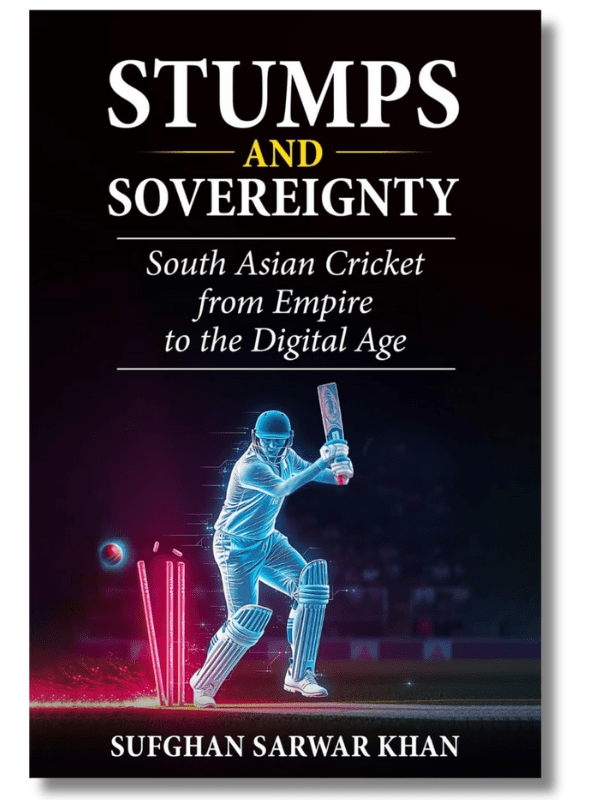Stumps and Sovereignty
by Sufghan Sarwar Khan
Genre: Nonfiction / Sports
ISBN: 9798895711866
Print Length: 384 pages
Reviewed by Peter Hassebroek
A resourceful overview of cricket’s past, present, and future with an emphasis on the sport’s influence on South Asian nations and vice versa
Events on the Indian subcontinent after World War II and the 1947 partition provide the dramatic impetus of Stumps and Sovereignty: South Asian Cricket from Empire to the Digital Age, a book about cricket that’s impressive and ambitious in scope and that largely succeeds in fusing together sport and politics without letting one overshadow the other. These events are sandwiched between a historical review of the sport’s beginnings in the late middle ages in England and a projection of its future spread, even beyond Earth. A span of time covering roughly a millennium, in six parts.
Parts I and II describe cricket’s origins in England in the 1400s, the formalization of rules and governance, as well as its early appeal to gamblers. It moves on to describe how cricket accompanies the East India Company during its colonial endeavors in the Indian subcontinent in the 18th century. There the game is first treated as a novelty by locals, then something to emulate, often with improvised equipment, before being taken up in earnest with an intent to compete globally.
Parts III, IV, and V zoom in on its spread in Asia after 1947 when India is divided to create Pakistan and East Pakistan (now Bangladesh). These and a couple of neighboring nations are given dedicated sections to describe their cricketing journeys, amid the background of their respective important national developments. This arrangement demonstrates how achievements and disappointments in cricket correlate to a nation’s political development, as exemplified by a 1952 Pakistan-India series:
“Critics dismissed Pakistan as raw and unready. Yet the response was immediate and emphatic. In the second Test at Lucknow, Pakistan shocked India with a resounding victory by an innings and 43 runs . . . It was more than a win—it was a declaration . . . the message was sent to the cricketing world. Pakistan had arrived and arrived with fighting spirit.”
India ended up winning that series, but as a moral victory it was a meaningful step for Pakistan in establishing its global identity, along with its sporting one. The book’s most engaging sections are when it connects athletic triumphs like this one to national identity.
Those parts cover nearly eighty years of often turbulent times. There is a lot of history and material to draw from, so naturally summarizations and selectiveness are necessary. Such as only briefly mentioning club teams and national leagues in lieu of more significant international contests. Even then, it’s more a catalog of logically grouped results, not necessarily in chronological order. The tone is akin to a sports-like highlight reel with occasional asides to talk about notable plays or players.
This approach is effective in illustrating how the shifting psyches of sport and nation reflect each other. While reading of setbacks and triumphs, whether against their fellow cricket up-and-comers or established nations like England and Australia, one shares the growing pains of these geopolitically young nations. Notably how their climbs to respectability rely on displaying resilience, a word frequently applied to describe this.
Part VI zooms back out and takes a different approach. One that’s more abstract in discussing today’s cricket in general, its issues, potential resolutions, and the ever-increasing utilization of technology. Cricket has become a leader in implementing creative ways to incorporate spectator participation, even ownership, remotely and at the cricket ground.
As for the future, there’s no holding back in contemplating what cricket’s embracing of technology might bring. Whether to expand its popularity or curtail its sociological impact in terms of climate change, sustainability, and other current issues. The examination of what’s possible is extensive, even venturing to imagine the sport repeating its colonialist path to the moon or even Mars.
Given such a broad, varied spectrum, the book’s chapters and parts do logically flow into each other. However, the varying writing styles give the sense of a work that’s been quilted together in essentially three patterns, and some of the flows feel inconsistent. The first is more conventionally historical while the second offers a more sports-centric aura. There are repetitions between others in the first five parts, including re-expanding already established acronyms, which contrasts the polished and grammatically perfect text of the sixth and last part. The last part, Part XI, is slick, much of it composed of the optimistic technological jargon one might find in a marketing document.
This is not an introduction to cricket. A degree of familiarity with cricket, its terminology and varying formats is helpful to appreciate all this book has to offer. For those with such awareness, Stumps and Sovereignty could serve as a useful textbook for in-depth courses about the sport. Especially one centered on South Asia for which it provides a thorough perspective on cricket before, during, and after colonial times.
Thank you for reading Peter Hassebroek’s book review of Stumps and Sovereignty by Sufghan Sarwar Khan! If you liked what you read, please spend some more time with us at the links below.
The post Book Review: Stumps and Sovereignty appeared first on Independent Book Review.
